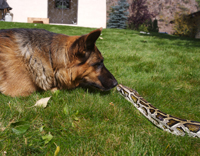A recently aired television program about a researcher who was bitten by a 12-foot python in Indonesia reminded some of our readers of Houdini, a local 12-foot python who received national fame last year when he swallowed an electric blanket.
Houdini is owned by Carl Beznoska, an experienced snake handler who lives north of Ketchum and has been bitten by pythons on numerous occasions.
"Usually, it's my fault," Beznoska said in an interview Friday. "I had a smell of food on my hands and when I reached in the cage they took me for food."
It's an easy enough mistake to understand. Pythons have no ears, so they can't hear. Their eyesight is poor, but they have a keen sense of smell. If it smells like food, they might just bite it.
That's the sort of mistake Houdini made in July of 2006, when an electric blanket got tangled up with his rabbit dinner and he swallowed the whole thing, including the control unit and cords. The blanket was surgically removed two days later by veterinarians Karsten Fostvedt and Barry Rathfon at St. Francis Pet Clinic in Ketchum. The publicity made Houdini an international celebrity.
Houdini is generally well behaved, gentle and even affectionate toward Beznoska, but he has bitten the hand the feeds him on more than one occasion. But that was in Houdini's younger days.
"It's been a long time since I've been bitten, because you learn from your mistakes," Beznoska said.
The television show on the researcher who was bitten in Indonesia aired last week on the National Geographic Channel's "Dangerous Adventures" program. There were follow-up interviews on the Today Show and other programs.
Herpetologist Brady Barr was working in a cave in Indonesia when he and the film crew came upon a 12-foot-long wild reticulated python. They grabbed the snake but it ducked its head under water and latched onto Barr's leg, leaving several long, gaping wounds. Barr survived the ordeal, which occurred about three months ago, but had some nice scars to show and an adventure to talk about.
As a reticulated python, the snake is a different species than Houdini, who is a Burmese python.
"It's like comparing a pit bull with a poodle," said Beznoska.
Reticulated pythons can grow up to 30 feet long, making them one of the largest snakes on Earth. They are native to India, the Philippines, Southeast Asia and Indonesia. They are not considered a good snake for pet owners, but they are bred and raised in captivity nonetheless.
Burmese pythons are native to many of the same areas as reticulated pythons but are found farther north into southern China and Pakistan. They grow to about 22 feet maximum and are a favorite of python fanciers because of their mellower disposition.
Beznoska has owned both types. Before Houdini, who Beznoska has had for about 16 years, he owned Monty, a reticulated python. He also once owned a boa constrictor named Gloria.
While Beznoska sometimes takes Houdini to school or library shows for children, he was reticent to do that with Monty.
"I wouldn't be able to let the kids handle him like I do Houdini," he said. "They're more unpredictable. It's a different mentality. They're more aggressive.
"Sometimes he would be aggressive, but in five minutes I could pick him up. You just have to watch them."
Beznoska owned Monty for about 10 years. Monty was more than 15 feet long before he had to be put to sleep because of a respiratory ailment that caused him to stop eating.
But despite the difference in temperament, "I've been bitten a number of times by all three of them," said Beznoska, including Gloria in his snakebite count. "They let go usually, when they realize they made a mistake."
Once when Houdini bit Beznoska the snake didn't immediately let go. Beznoska dragged him over to the sink and ran cold water on his head until he did.
Pythons and other constrictors don't bite to inflict harm. They bite to hold their prey until they can coil around and suffocate the unfortunate victim.
Although instinct argues against it, Beznoska said the best thing to do if bitten by a python or boa is not to jerk away but hold still until they let go. They have some 100 razor sharp pointed teeth that tear flesh if pulled. By holding still, you can end up with some puncture wounds, but not the nasty gashes that the researcher experienced in the Indonesian episode.
Houdini is now 19. He likes to spend most of his days, especially cold ones, curled up in his large cage. No longer do electric blankets keep him warm. He now has the comfort of heated floor tiles that Beznoska installed after the blanket-eating episode. Beznoska often leaves the cage door open so Houdini can come and go as he pleases.
"He just likes to hang outside the cage or on top of it for a day or two," Beznoska said. "He doesn't like to roam around too much; he's part of the household."
Houdini shares the household with Raiko, a German shepherd that Beznoska describes as a "police-school dropout because he wasn't mean enough."
Dog and snake seem to have a well-defined relationship.
"Houdini ignores Raiko, and Raiko stays out of his way," Beznoska said.


 Houdini, a Burmese python that gained worldwide fame last year, touches noses with Raiko, a German shepherd police-school dropout, at owner Carl Beznoska?s home north of Ketchum. Houdini is a mild-mannered python, but he?s still capable of delivering a nasty bite, as Beznoska has learned on a couple of occasions.
Photo by David N. Seelig
Houdini, a Burmese python that gained worldwide fame last year, touches noses with Raiko, a German shepherd police-school dropout, at owner Carl Beznoska?s home north of Ketchum. Houdini is a mild-mannered python, but he?s still capable of delivering a nasty bite, as Beznoska has learned on a couple of occasions.
Photo by David N. Seelig



































